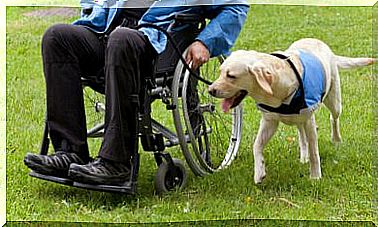Did You Know That Dogs Recognize Tone Of Voice?

Dogs perceive the feelings implicit in our tone of voice. Their brain is able to process what is said, but also the intentions and emotions in the human voice.
According to some studies, dogs know the mood of their owners and their intentions thanks to the emotions that emerge from the tone of voice. All of this could explain why they obey us.
Why do they recognize our tone of voice?

The results of several studies have shown that the language processing system in the brain of dogs splits into two hemispheres, in a very similar way to what happens in humans.
Just like us, in fact, each of the two cerebral hemispheres of dogs specializes in understanding different aspects of communication. On the one hand, directly understandable language (words and phrases), on the other, non-verbal language (gestures and intonation).
The next step to deepen will be to understand if the ability to recognize our tone of voice is the product of the evolution of dogs as a species, or if it is linked to the domestication process carried out by man.
Dogs can therefore understand some aspects of human language in a similar way to us, a skill that has proved to be fundamental over the centuries for their domestication.
What dog owner has never thought at least once that his four-legged friend understood what he was saying?
The tone of voice, beyond words
Some experts believe that dogs are able to recognize certain passages of human conversations, and even some phonemes within sentences.
In a conversation, words aren’t everything. Elements such as intonation play an important role in communication, and various parts of the brain are involved in processing these nuances.
The domestication process
How did the adaptation process that led the dogs to be able to recognize our tone of voice come about? The domestication of the dog, the ability of this animal to respond to human orders, played a fundamental role in its adaptation. The hypothesis that this is a common feature of various mammal species should not be ruled out.
Another peculiarity is linked to the fact that dogs can distinguish, only by listening to the voice, if the speaker is a man or a woman, just as a person would do, and they are even able to associate the voice with a face.
Several scientists also believe that a dog’s intelligence is comparable to that of a two-year-old.
How were the studies conducted?
During the tests, the team of researchers reproduced several pre-recorded voice messages analyzing the reaction of the animals involved. Some played a voice that said “come here” in a monotone, without intonation. Others were saying nothing understandable but using a positive tone of voice.
Based on the side to which the dog’s head was turned, it was possible to determine which brain hemisphere had processed the information first. In other words, if the dog looked to the left, it meant that the sound was heard more loudly from that side.
The results of the test have served to confirm that the brain of dogs is in this respect very similar to that of humans.
Some of the smartest breeds

Although each dog is unique in itself and within each breed there may be specimens with different characteristics, there are some breeds of a more “active and alert” nature than others.
The Rottweiler and Labrador, for example, are renowned for their intelligence. Because of their strong jaws and teeth, Rottweilers are sometimes used as police dogs.
The Labrador, for its part, is one of the most intelligent dogs in the world and also one of the most widespread breeds, used to play many roles. They originated in the city of Newfoundland and were originally trained to hunt waterfowl.
As time went on, Labradors were introduced to new activities. Many of them are used by the public forces as bomb or drug dogs. Any dog that can be trained for this type of activity is considered an intelligent dog.
Labradors are also used for water rescue, while many are trained to support people with disabilities, especially blind people. These animals can in fact learn to guide a human being without paying attention to any distractions.









